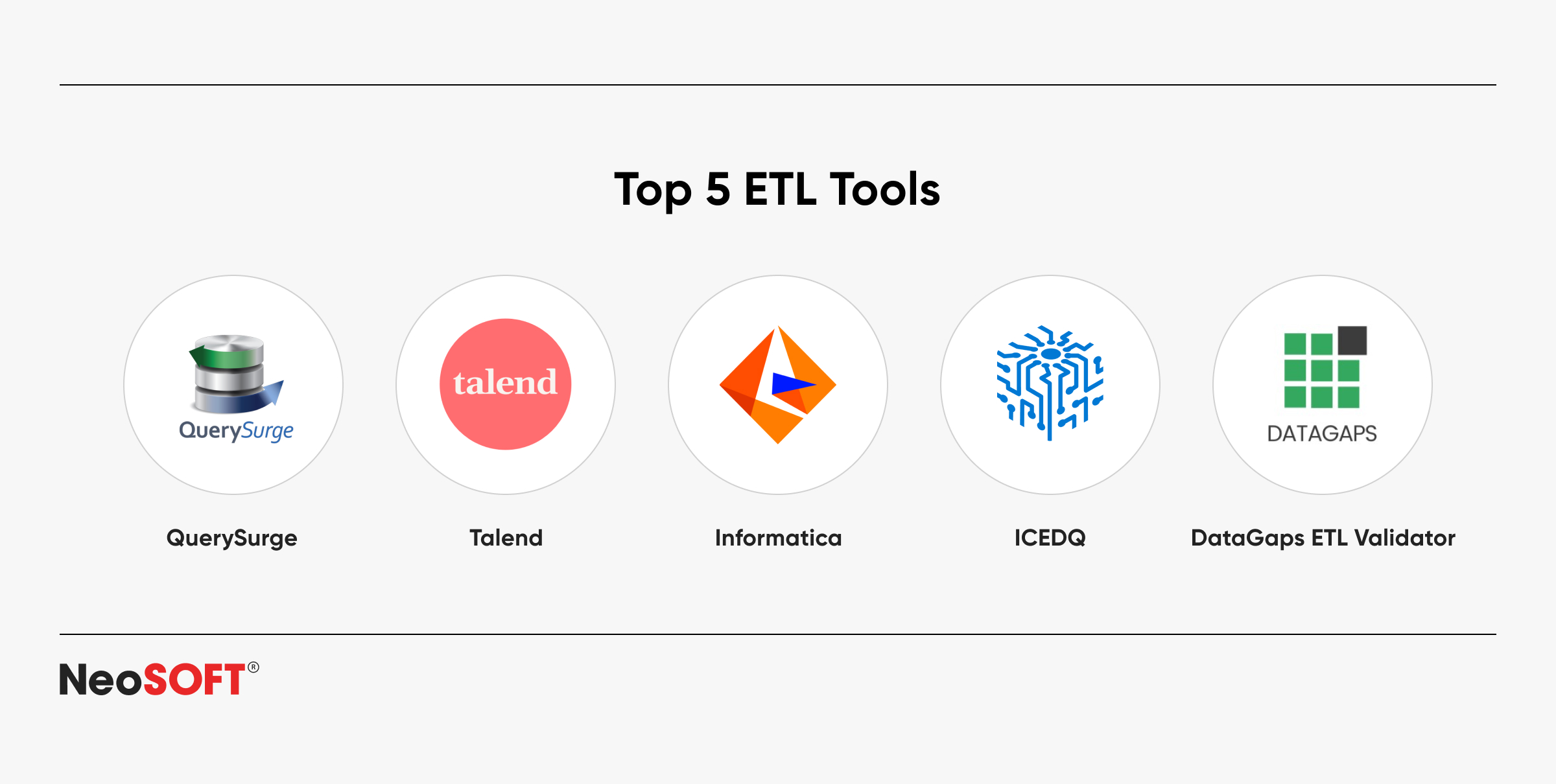ETL Testing Challenges: Effective Data Integration Solutions
September 2, 2024
Introduction
Companies of all kinds across industries rely heavily on data in today’s data-driven economy to improve product development processes, customer experiences, expedite operations, and make sound choices. In order to transfer data from the source system to the destination data warehouse while maintaining the integrity of the data throughout the process, ETL testing processes are vital.
Nevertheless, ETL testing concepts can present challenges such as maintaining large amounts of data, assuring accurate data, and conducting complicated data warehouse testing. Failure to resolve these issues might lead to incorrect business intelligence reports and low data quality.
To solve these challenges, firms must have data capabilities and create a thorough ETL testing strategy that includes specific ETL testing tools. This blog provides an overview of the major issues that ETL testing presents and offers solutions to create a stable integration environment.
ETL Testing, Explained
ETL (Extract, Transform, Load) is a vital data management process for data analytics that involves extracting data from multiple users and numerous sources, transforming it to comply with specific business standards and data structures, and plugging it into a data warehouse for analysis. This strategy is critical for ETL projects that focus on integration, migration, guaranteeing data quality in business intelligence reports.
ETL testing focuses on several key areas:
- Data Extraction: Ensuring accurate extraction of data from diverse sources.
- Data Transformation: Validating that data transformation rules align with business requirements and mapping specifications.
- Data Loading: Verifying that transformed data is loaded properly into the target databases.
- Data Validation: Conducting thorough validation tests for data accuracy, completeness, and quality assurance.
Challenges in ETL Testing
Data Quality Issues
Challenge: Poor data quality from source systems is a significant obstacle, leading to inaccurate insights and decisions.
Solution: Implement all the expected data quality testing at the both source and target level to identify and rectify issues before they propagate through the ETL process. Employ automated ETL data quality testing tools to continuously monitor data model quality.
Handling Large Data Volumes
Challenge: ETL processes often need to manage large volumes of data, posing challenges for timely and efficient processing.
Solution: Use ETL performance tests to optimize the actual data load process. Implement incremental ETL testing to handle large data volumes by processing only new or modified data.
Complexity of Data Transformations
Challenge: Complex business and transformation rules can introduce errors and inconsistencies.
Solution: Document rules of data transformation thoroughly and conduct detailed data transformation testing. Leverage automated testing tools to validate transformation logic against expected outcomes.
Diverse Data Sources
Challenge: Integrating and processing data from multiple, heterogeneous source systems with varying structures and formats can be challenging.
Solution: Standardize mapping document data formats and perform robust data integration testing to ensure seamless data flow from source to the target data warehouse system. Regularly update mapping documents to reflect changes in source and target data.
Ensuring Data Completeness and Accuracy
Challenge: Ensuring that all expected data is accurately extracted, transformed, and loaded, especially for data values in large datasets, can be difficult.
Solution: Conduct data completeness testing to ensure no relevant data is lost during the ETL process. Compare the source data and target data during validation tests to verify integrity and accuracy.
Maintaining Data Integrity
Challenge: Preserving the integrity of the data by maintaining relationships and constraints during the ETL process is crucial.
Solution: Use integrity tests to ensure that constraints and relationships are upheld. Implement metadata testing to verify consistency in data definitions and relationships.
Regression Testing
Challenge: Changes in source data or a target data warehouse can introduce new errors or affect existing functionality.
Solution: Implement automated regression tests to quickly identify and resolve issues caused by changes in the ETL process. Maintain a comprehensive suite of test cases to cover various scenarios.
Performance Testing
Challenge: Ensuring that the ETL process meets performance requirements is critical, particularly when dealing with complex transformations and large data volumes.
Solution: Conduct performance tests to identify and eliminate bottlenecks. Optimize ETL scripts and utilize efficient data processing techniques to enhance performance.
Migration Challenges
Challenge: The process of moving data to a new system from an existing data warehouse comes with the chance that it will be corrupted, lost, or experience data loss.
Solution: Plan and execute the migration projects meticulously, with thorough testing at each stage. Verify the accuracy of the data before, during, and after the migration.
Cloud Data Integration
Challenge: Compatibility, latency, and data security are among the additional difficulties that come with integrating cloud data with on-premise systems.
Solution: Utilize cloud-native data warehousing tools and create solid data integration methods. Perform extensive testing to ensure data security and performance in the source and target cloud environment.
Overcoming ETL Testing Challenges
To effectively address ETL testing challenges, well-structured ETL testing is essential. The steps given below outline a systematic approach to implementing an effective ETL testing process:
- Requirement Analysis: Identify data sources, migration logic, and destination systems. Define clear testing objectives and success criteria.
- Test Planning: Create a thorough test strategy that includes all test scenarios, data, tools, and timetables. Determine the important parties and the responsibilities they play in the testing procedure.
- Test Case Design: Make thorough test cases that address every facet of ETL testing, such as loading, validating, transforming, and extracting data. Make sure test cases confirm the completeness, accuracy, and integrity of the data.
- Test Data Preparation: Assemble test data that faithfully replicates actual situations. Make sure it includes a variety of data types, formats, and edge cases by using data profiling.
- Test Execution: Execute test cases in a controlled environment. Make use of automated testing solutions to improve efficiency and expedite the testing process.
- Defect Management: Keep track of and handle any flaws found during testing. Make use of defect management systems to quickly identify and address problems.
- Regression Testing: Carry out thorough regression testing to make sure that modifications don’t cause new problems. Keep up a regression test suite that includes all necessary features.
- Performance Testing: Conduct performance tests to locate and fix performance bottlenecks. Optimize ETL scripts and configurations to enhance performance.
- Reporting and Documentation: Record test findings, flaws, and fixes. Send thorough reports outlining the main conclusions and suggestions to the relevant parties.
- Continuous Improvement: Review and improve the ETL testing regularly. Incorporate feedback from previous testing cycles to enhance future efforts.
Leveraging ETL Testing Tools
ETL testing process effectiveness and efficiency can be greatly increased by using ETL testing tools. Some popular ETL testing tools and their key features are:
- Informatica: Provides extensive functionality for integration and automation, ensuring the correctness, integrity, and completeness of the data.
- Talend Open Studio: An open-source solution for data transformation and integration that facilitates automated testing.
- QuerySurge: A tool specifically designed for ETL testing that automates validating data and testing across warehouses and big data platforms, offering CI/CD integration and detailed reporting.
- ICEDQ: Provides automated data testing and validation for ETL processes, supporting integrity, completeness, and accuracy testing with real-time monitoring and reporting.
- DataGap ETL Validator: Offers end-to-end validation and ETL testing capabilities, supporting data quality and regression testing with detailed reporting and analytics.
ETL Testing Best Practices
ETL testing can be made even more effective by implementing best practices. Here are some essential best practices:
- Early Involvement: Engage ETL testers early in the development phase to proactively address potential issues.
- Extensive Test Coverage: Make sure your test cases address every facet of ETL testing, such as loading, validation, data extraction, and transformation.
- Automated Testing: Use automated testing techniques can increase output, reduce manual labor, and ensure consistent test execution.
- Continuous Integration: Use ETL integration testing into the continuous integration pipeline to detect and resolve issues early on in the development cycle.
- Data Profiling: Identify data quality issues and understand the characteristics of the original data.
- Collaboration: Encourage communication between developers, software testers, and business executives to ensure knowledge of requirements and project goals.
- Documentation: Keep detailed records of test cases, results, errors, and solutions to support future testing projects.
- Performance Optimization: Monitor and adjust ETL operations on a continuous basis to guarantee that data is processed efficiently.
Addressing Specific ETL Testing Scenarios
Different ETL testing scenarios require tailored approaches to address specific challenges. Here are some common ETL testing scenarios and strategies to handle them:
Data Migration Testing
Scenario: Transferring data to a cloud data warehouse from outdated systems.
Strategy: Divide the data migration project into more manageable stages, and make sure each stage is well tested. Make sure to verify the integrity of the data throughout the process. Use data testing and profiling to identify potential issues in source systems.
Data Integration Testing
Scenario: Creating a data lake or unified data warehouse by integrating data from various, dissimilar sources.
Strategy: Standardize data formats and perform comprehensive data integration testing. Regularly update mapping documents to reflect changes in origin data. Use automated unit testing tools to streamline validation and ensure consistency.
Data Transformation Testing
Scenario: Applying complex business rules and transformation logic to source and target data.
Strategy: Document data transformation guidelines thoroughly and perform detailed testing. Leverage automated testing tools to validate transformation logic against expected outcomes. Ensure that transformed data meets business requirements.
Regression Testing
Scenario: Ensuring that changes in source systems or target data warehouses do not introduce new errors.
Strategy: Implement automated regression tests to quickly identify and resolve issues caused by changes. Maintain a comprehensive suite of test cases to cover various scenarios and perform regression tests regularly.
Additional Strategies to Boost Efficiency in ETL Testing
- Data Validation Techniques – Conduct rigorous data validation tests to ensure accuracy. Utilize SQL queries to validate data types, ranges, patterns, and uniqueness constraints against expected outcomes in the source and the target database systems.
- Metadata Testing – Validate metadata to ensure consistency and accuracy. Check data definitions, models, and transformations to ensure alignment with business rules and requirements.
- Test Data Management – Manage test data effectively to ensure accurate ETL testing. Use data masking techniques to safeguard sensitive customer data while testing and ensure that test data reflects real-world scenarios.
- Automated ETL Testing – Increase accuracy and efficiency using automated testing tools. Regularly schedule automated tests to ensure ongoing validation of ETL processes and early issue detection.
- ETL Test Scenarios – Develop comprehensive test scenarios covering a wide range of use cases, including regression tests, integration, and transformation. Ensure scenarios address specific business rules and transformation thinking.
- Monitoring and Alerting – Implement monitoring and alerting to track ETL processes in real-time. Alerts notify testers of anomalies, enabling prompt resolution and minimizing the impact on data quality and integrity.
- Performance Optimization – Continuously optimize ETL processes for better performance. Use indexing, parallel processing, and efficient data transformations to enhance speed and efficiency. Conduct performance tests to identify and resolve bottlenecks.
- Collaboration with Business Stakeholders – Involve business stakeholders in the ETL development and testing procedure to ensure that transformations align with business requirements. Regular feedback helps refine strategies and improve data quality.
- Documentation and Reporting – Maintain comprehensive documentation of ETL processes, test cases, results, and defect resolutions. Detailed reports provide transparency and help stakeholders understand the effectiveness of ETL testing.
- Continuous Improvement – Regularly review and refine ETL testing strategies. Incorporating tools and lessons learned from past cycles to enhance future efforts ensures improvement in data validation, integration, and quality testing.
Conclusion
To guarantee correct and reliable data transfer from source data systems to destination warehouses, ETL testing is essential. Businesses can develop strong ETL testing methods that improve data reliability and integrity by addressing issues such as data quality, huge volumes, complex transformations, and various data sources.
Using automated ETL testing tools, following best practices, and encouraging engagement by stakeholders will result in successful ETL outcomes. In a data-driven environment, successful ETL testing ensures data integrity and maximizes value, supporting business goals and competitive advantage.
Our expert software testing staff ensures that your data integration project is successful, reliable, and in line with your company goals. For skilled ETL testing services and comprehensive software QA solutions, reach out to us today at [email protected].





















